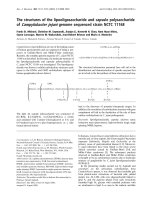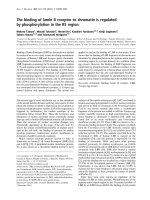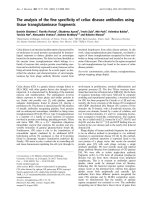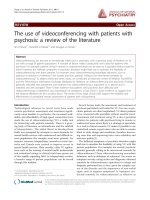Báo cáo y học: "The Nordic Maintenance Care Program – An interview study on the use of maintenance care in a selected group of Danish chiropractors" pdf
Bạn đang xem bản rút gọn của tài liệu. Xem và tải ngay bản đầy đủ của tài liệu tại đây (227.6 KB, 7 trang )
BioMed Central
Page 1 of 7
(page number not for citation purposes)
Chiropractic & Osteopathy
Open Access
Research
The Nordic Maintenance Care Program – An interview study on the
use of maintenance care in a selected group of Danish chiropractors
Lars Top Møller*
1
, Michael Hansen
2
and Charlotte Leboeuf-Yde
3
Address:
1
Private practice, Grenaa, Denmark,
2
Private practice, Haderslev, Denmark and
3
Research Unit for Clinical Biomechanics, University of
Southern Denmark, Backcenter Ringe, Lindevej 5, DK-5750 Ringe, Denmark
Email: Lars Top Møller* - ; Michael Hansen - ; Charlotte Leboeuf-
Yde -
* Corresponding author
Abstract
Background: Although maintenance care appears to be relatively commonly used among
chiropractors, the indications for its use are incompletely understood. A questionnaire survey was
recently carried out among Swedish chiropractors in order to identify their choice of various
management strategies, including maintenance care. That study revealed a common pattern of
choice of strategies. However, it would be necessary to verify these findings in another study
population and to obtain some additional information best collected through an interview.
Objectives: The main aim of the present study was to attempt to reproduce the findings in the
Swedish study and to obtain more information on the use of maintenance care.
Method: A group of 11 chiropractors were selected because they used maintenance care. They
were interviewed using the questionnaire from the previous Swedish survey. The questionnaire
consisted of a simple description of a hypothetical patient with low back pain and nine possible ways
in which the case could develop ("scenarios"). They could choose between six different
management strategies for each scenario. In addition, the chiropractors were encouraged to
provide their own definition of maintenance care in an open-ended question. Interviews were
taped, transcribed and analyzed. For the open-ended question, statements were identified relating
to six pre hoc defined topics on the inclusion criteria/rationale for maintenance care, the frequency
of treatments, and the duration of the maintenance care program.
Results: The open-ended question revealed that in patients with low back pain, maintenance care
appears to be offered to prevent new events. The rationale was to obtain optimal spinal function.
There appears to be no common convention on the frequency of treatments and duration of the
treatment program was not mentioned by any of the interviewees.
Conclusion: The results from the questionnaire in the Danish survey showed that the response
pattern for the nine scenarios was similar to that obtained in the Swedish survey. There seems to
be relative agreement between chiropractors working in different countries and sampled through
different methods in relation to their choice of management strategies in patients with low back
pain. However, more precise information is needed on the indications for maintenance care and its
treatment program, before proceeding to studying its clinical validity.
Published: 17 June 2009
Chiropractic & Osteopathy 2009, 17:5 doi:10.1186/1746-1340-17-5
Received: 29 September 2008
Accepted: 17 June 2009
This article is available from: />© 2009 Møller et al; licensee BioMed Central Ltd.
This is an Open Access article distributed under the terms of the Creative Commons Attribution License ( />),
which permits unrestricted use, distribution, and reproduction in any medium, provided the original work is properly cited.
Chiropractic & Osteopathy 2009, 17:5 />Page 2 of 7
(page number not for citation purposes)
Introduction
Secondary and tertiary prevention (so-called maintenance
care) appears to be a relatively common clinical manage-
ment strategy among some chiropractors. Although it
appears to be a reasonable approach in patients with
recurring back problems, an overzealous use of prolonged
treatment programs would threaten the credibility of the
chiropractic profession.
The scientific literature on this subject is sparse. Therefore,
the use of maintenance care is not based on evidence. For
example, its exact indications have not been clarified nor
is it known if maintenance care has the intended effect.
Only one study on treatment effect has been published; a
pilot study on patients with low back pain but with incon-
clusive results [1]. Several authors have surveyed the chi-
ropractor profession with the intent of learning more
about maintenance care, but most study samples were
probably unrepresentative of the chiropractic profession
and therefore of little use [2,3].
Obviously, this is an important subject that deserves seri-
ous study. The ultimate goal would be to establish if
maintenance care is clinically useful, and if so, for which
type of patients and which type of approach. A literature
review, published in 1996, concluded that it would be
necessary to perform a series of preliminary studies to
delineate the parameters of care, before being able to con-
duct a large-scale multi-center clinical trial [2]. A recent
review concluded that scientific status of maintenance
care was largely unchanged [3]. For that reason the need
persists to perform a number of preliminary studies.
Therefore, before embarking on such a largely unstudied
method of treatment, it would be necessary to find out,
first, when it is commonly used in daily clinical practice,
and when it is considered definitely unsuitable. For this
purpose, a number of studies were carried out. For exam-
ple, a questionnaire survey was recently conducted among
a selected group of Swedish chiropractors, in which a
basic case was described of a patient with low back pain
who had undergone an initial period of chiropractic care
[4]. The participants were asked to choose between several
follow-up management strategies. These strategies went
from referring the patient out for a second opinion to
advising the patient to remain in a maintenance care pro-
gram. The results revealed that there was fair agreement
among the participants on the choice of management
strategies, notably for scenarios that indicated the need for
clinical vigilance.
However, this survey did not provide any information as
to whether chiropractors also consider primary preven-
tion as a form of maintenance care. It was also unclear if
the response pattern would be similar in different study
populations.
We therefore decided to approach the same subject in dif-
ferent study populations. Consequently, two additional
studies were performed; one in Denmark and the second
in Finland. This report deals with the Danish study, which
consisted of an interview with a small group of chiroprac-
tors, specifically selected because they used maintenance
care in their practice. They were chosen to ensure that we
would get informed answers on maintenance care. By col-
lecting the information in this study through an interview,
we hoped also to be able to capture some more subtle
points, which might have gone undetected in the previous
questionnaire study, and it made it possible to solicit the
chiropractors' own definitions of maintenance care.
Method
Procedure
Eleven Danish chiropractors were selected by a senior chi-
ropractor with knowledge of their clinical practice profile.
The inclusion criteria were that they used maintenance
care and were willing to submit to the interview. The inter-
view instrument (described below) was sent out per mail
and replied to in a subsequent telephone interview, con-
ducted by the first two authors, who also analyzed the
data.
The structured interview
The same questionnaire as that used in the previous Swed-
ish survey was employed [3]. It had been designed by the
group of Swedish chiropractors, who were responsible for
the first survey, and further refined in a series of small
pilot tests, in which the intellectual quality and clarity of
the questions was addressed. The questionnaire that was
written in English consisted of a basic case, describing a
hypothetical patient with low back pain.
The basic case was described as follows: "A 40-year old man
who consults you for low back pain with no additional spinal or
musculoskeletal problems, and with no other health problems.
There are no aggravating factors at work or at home. His X-rays
are normal for his age. There are no "red flags"."
This case was followed by a description of nine possible
ways in which this case could develop ("scenarios")
(Additional file 1). For each scenario the respondents
could choose between six different clinical management
strategies in response to the question: "What would you
recommend?" In the questionnaire, these are listed under
A-F. An additional, "neither of the above, please explain"-
alternative was also available (G), with the possibility to
provide ones own alternative answer (Additional file 2).
Chiropractic & Osteopathy 2009, 17:5 />Page 3 of 7
(page number not for citation purposes)
Replies to the questionnaire were noted by the interview-
ers as categorical answers, i.e. strategy A, B, or C etc. Sug-
gested additional strategies were noted down. If a new
suggested alternative (G) was, in fact, identical with one of
the previously suggested alternatives, it was placed under
the correct alternative. Combinations of replies were
coded as "several replies" and only truly original sugges-
tions could be left under alternative "G", i.e. "None of the
above, please explain".
The interpretation of all replies was done independently
by the first two authors. Answers on which both agreed
were considered factual. In cases of disagreement, the
third author would be called in.
The replies to each question were reported as numbers
and percentages and compared with the previous results
obtained in the Swedish study. For ease of comparison,
results from the Swedish study are included in the Table 1.
The most commonly selected management strategy was
Table 1: How 11 Danish chiropractors, who use maintenance care, would choose their continued case management strategies in nine
hypothetical case scenarios for a patient with low back pain
The nine case
scenarios
Strategy A
"2
nd
opinion"
Strategy B
"Quick-fix"
Strategy C
"Try again"
Strategy D
"Ext. help –
keep in touch"
Strategy E
"Symptom-
guided MC"
Strategy F
"Clinical
findings-guided
MC"
Several replies
1.
DK 0 55 18 0 9 18 0
S 0 54 2 0 20 19 2
2.
DK 027180 36 18 0
S 01430 44 30 2
3.
DK 0064 18 9 0 9
S 20 0 42 12 8 10 0
4.
DK 0000 72 28 0
S 0733 46 34 0
5.
DK 9036 927180
S 14 0 25 17 10 24 2
6.
DK 0055 27 18 0 0
S 5037 29 7 10 2
7.
DK 0055 918180
S 15 2 32 15 12 8 2
8.
DK 55 0270 0 0 18
S5901414 0 0 2
9.
DK 45 01827 0 0 9
S5908 19 0 0 2
Descriptions of the nine case scenarios (1–9) and the six main management strategies (A-F) are found in Additional files 1 and 2. The estimates from
a previous Swedish survey (N = 59) have been incorporated in the table, listed below those from the Danish interview. The results are reported as
percentages and the largest estimate for each case scenario has been highlighted.
DK = Results from present Danish interview
S = Results from previous Swedish survey (3)
MC = Maintenance care
Chiropractic & Osteopathy 2009, 17:5 />Page 4 of 7
(page number not for citation purposes)
identified for each scenario. To make the report more
reader-friendly, the first six of these management strate-
gies have been described also in brief, colloquial terms, as
shown in Additional file 2.
The open-ended question: "What is your definition of the
concept of maintenance care?"
In addition, the chiropractors were encouraged to provide
their own definition of maintenance care as response to
an open-ended question ("What is your definition of the
concept of maintenance care?"). These interviews were
taped, transcribed and analyzed. Already during the inter-
views it became clear that the chiropractors generally
failed to provide a clear definition of maintenance care
but that they rather described various aspects associated
with it. For this reason, we had to approach the analysis in
a different way by specifically looking for statements that
related to 6 pre hoc defined headings relating to: 1) LBP
history, 2) type of symptoms, 3) severity of symptoms, 4)
specific objective findings, 5) frequency of treatments,
and 6) duration of maintenance care program. Statements
that did not fit under any of these headings would be
listed separately with the intent of finding additional
descriptors under which they could be classified. Explana-
tions relating to the definition of maintenance care were
thereafter placed under the relevant pre- and post hoc
defined headings. This analysis was done independently
by the first two authors. Items on which both agreed were
considered factual. Cases of disagreement would be dis-
cussed with the third author. Finally, the frequency of
statements under each heading was quantified and
entered into a table.
Proportion of patients treated with maintenance care
At the interview, the participants were asked to identify
the number of patients receiving maintenance care out of
their total number of patient visits, on the day of the inter-
view. From this information it was possible to calculate
the percentage of maintenance care patients seen by each
chiropractor, and the mean and median values for the
whole group.
Ethics
The participants were known to the first two authors, and
the interviews were recorded, later to be transcribed, with
the permission of the interviewees. To protect their ano-
nymity, no names were included in the transcribed docu-
ment and tapes were destroyed as soon as the written text
was available thus cutting the link between the partici-
pants and their responses. No permission from the local
ethics committee is needed for this type of project.
Results
The eleven interviewed chiropractors reported having had
a mean of 35% and median of 42% of maintenance care
patients on the day of the survey, ranging from 0% to
70%. The chiropractor with 0% stated that he/she, excep-
tionally, did not have any such patients on that day but
would normally see patients under maintenance care pro-
grams.
The use of maintenance care according to the structured
interview – results of the Danish study
No problems in understanding or relating to the ques-
tions of the survey were noted among the respondents.
Also the analysis was unproblematic.
As can be seen in Table 1, maintenance care would be rec-
ommended by at least some of the respondents for all but
the last two scenarios. Both symptom-guided and clinical
findings-guided maintenance care were noted for the
remaining scenarios.
Some type of maintenance care was the most common
answer for scenarios 2, 4 and 5. The largest degree of con-
sensus was noted for scenario 4, which described quick
and full recovery in a patient with recurrent symptoms.
"Symptom-guided maintenance care" was the preferred
answer for 72% whereas the remaining 28% would rec-
ommend "clinical findings-guided maintenance care", i.e.
100% would recommend maintenance care.
In all 54% would recommend some type of maintenance
care for scenario 2; a worried patient who asks for mainte-
nance care but who had only 2 days' of LBP and no previ-
ous history. For scenario 5, which is described as a patient
with several short-lasting events over the past year but
with no obvious improvement after 6 visits, some type of
maintenance care was also considered relevant by 55% of
the respondents. However, the single most common
response for scenario 5 was "try again".
On the other hand, none of the participants suggested any
form of maintenance care for scenario 8 (patient getting
gradually worse) or scenario 9 (fluctuating symptoms
with signs of co-morbidity). Instead, the largest groups
(55% and 45%, respectively) agreed that such patients
should be submitted to a "second opinion".
More than half of the group agreed on the "quick fix"
approach in scenario 1 (immediate recovery and no previ-
ous low back pain).
Almost 2/3 would "try again" with the patient in scenario
3 (unexpected lack of improvement in seemingly uncom-
plicated case). "Try again" was the preferred management
strategy also in scenario 6 (initial substantial improve-
ment followed by stagnation), and in scenario 7 (initial
substantial improvement followed by gradual worsen-
ing).
Chiropractic & Osteopathy 2009, 17:5 />Page 5 of 7
(page number not for citation purposes)
Strategy D ("external help – keep in touch") or strategy G
("other") were never the most often selected responses.
Open-ended question: "What is your definition of the
concept of maintenance care?"
Only one of the chiropractors expressively defined main-
tenance care, using the terms of primary, secondary and
tertiary prevention, stating that he/she would use mainte-
nance care synonymously with secondary and tertiary pre-
vention only, and. not as a means to prevent the incidence
of low back pain (primary prevention).
The other chiropractors preferred to describe the typical
maintenance care patient and how this patient would be
managed. As can be seen in Table 2, answers were found
that fitted four of the six pre-defined headings (1) history
of low back pain, 2) type of symptoms, 3) severity of
symptoms, and 6) frequency of treatments. None men-
tioned 4) specific objective findings or 6) duration of
maintenance care program. One extra heading was identi-
fied: 7) aim of the maintenance care program. There were
no problems associated with placing statements under the
relevant headings.
In order of the frequency with which the information was
provided, maintenance care can be described as follows:
The aim is to prevent relapses by improving spinal func-
tion, and the consultation is a "check-up". Thus, it is irrel-
evant whether the patient has symptoms or not and the
severity of symptoms is also not important. The frequency
with which the patient is scheduled would vary with the
needs of the patient, probably between 1 and 6 months,
with 3 months being relatively common. An indication
for maintenance care would be recurrent symptoms over
a long period of time.
Discussion
This was a study of a small group of Danish chiropractors
and their theoretical approach to the long-term manage-
ment of low back pain. They could choose between 6
management strategies for 9 different scenarios. Two of
these strategies consisted of different types of mainte-
nance care. We noted that there was a fair amount of con-
cordance in their choices of strategies.
The participants in the Danish study had been selected
because they were known to use maintenance care, so we
would have expected them to have a higher usage of main-
tenance care, as compared to a larger group of Swedish
chiropractors, who had been selected on other inclusion
criteria for participation in a previous questionnaire sur-
vey [4]. This was true, as their median number of mainte-
nance care patients was about twice as high as that of the
Swedish participants (42% vs. 20%).
Despite this difference, the overall results of the present
study mirrored those of the previous Swedish study
because, in both study groups, the majority of participants
selected the same management strategies. For example,
the two groups largely agreed on when to refer patients for
Table 2: Results from the open-ended question: "What is your definition of the concept of maintenance care?" Interview of 11 Danish
chiropractors who use maintenance care
Type of information Description of responses
1. History of low back pain Three chiropractors mentioned the patient's history, stating that maintenance care was suitable for
patients who had recurrent symptoms over a long period.
2. Type of symptoms Seven of the chiropractors mentioned or implied that maintenance care patients do not necessarily
have to have any symptoms, when coming to the clinic for a "check up".
3. Severity of symptoms Six of the chiropractors mentioned that maintenance care can be offered regardless the severity of
symptoms.
4. Specific objective findings -
5. Frequency of visits Five of the respondents mentioned the frequency with which they would schedule visits for their
maintenance care patients. The total range was between 1 and 6 months and three mentioned an
interval of 3 months. They also mentioned that the timing of appointments would vary with the needs
of the patient.
6. Duration of maintenance care program -
7. Aim of the maintenance care program Ten of the eleven chiropractors agreed that the main purpose of maintenance care is to check up on
the patient. They all intended to help the patient improve spinal function, hereby avoiding a relapse of
symptoms.
Chiropractic & Osteopathy 2009, 17:5 />Page 6 of 7
(page number not for citation purposes)
a second opinion, when to consider the treatment com-
pleted, when to continue the treatment a few times more,
and when maintenance care would be their strategy of
choice. Hence maintenance care was not more often the
predominant answer for the Danish than for the Swedish
respondents. Nor was clinical findings-guided mainte-
nance care generally more commonly selected in the Dan-
ish than in the Swedish study. Although we could find no
specific information in other studies on this topic, this
could indicate that the chiropractic clinical approach to
this type of patient is fairly universal.
As in the Swedish study, maintenance care was never
thought to be relevant for patients who obviously should
be referred out for a second opinion. It would therefore
appear that also these chiropractors have a safe approach
to the long-term management.
The strongest support (100%) for maintenance care was
found for the fourth scenario, a patient with recurring
back problems and good recovery. On condition that one
believes in the usefulness of this approach, for us, we con-
sidered this case to be the most suitable indication for
maintenance care.
However, there was one response that surprised us.
Although the most common single answer to scenario 5 (a
patient who failed to improve after six visits) was to "try
again" (45%), there was an equally strong preference for
some sort of maintenance care. We would have expected
that improvement would have been a prerequisite for
maintenance care. Also in the Swedish survey the com-
bined result for the two types of maintenance care
exceeded the most commonly selected choice ("try
again"). We therefore conclude that it would be necessary
to study more closely the short-term outcome criteria for
patients considered suitable for maintenance care.
We were curious to see, if the use of clinical findings-
guided maintenance care would be more commonly con-
sidered in this group of practitioners than in the more
diversified group surveyed in Sweden. In other words,
would these chiropractors ignore patients' symptoms and
base their treatment on clinical findings only, such as pal-
pation? Interestingly, this was the case in only 1 of the 9
scenarios. It therefore looks as if the group of Danish chi-
ropractors took notice of their patients' symptoms and
not only their own examination findings.
Interview vs. mail survey – validation of the questionnaire
In a short questionnaire, it can be difficult to convey
meaningful clinical information to be understood by a
wide variety of individuals. By using the same question-
naire as in the Swedish study but collecting the informa-
tion through a structured interview, it would be possible
to pick up any misunderstandings or comments that
could shed light on problems of interpretation in the orig-
inal questionnaire. Fortunately, the interview revealed no
difficulties for the chiropractors to understand or relate to
the questionnaire.
Open-ended question-results
The present study included also an open-ended question
that was meant to shed some more light on the definition
of maintenance care. However, with one exception, the
chiropractors in the present study did not provide distinct
definitions of maintenance care but approached the ques-
tion indirectly, by describing some clinical aspects
thereof.
In doing so, they did not describe any conditions or pro-
files or any standard management programs. Rather, their
responses indicated that maintenance care can be used for
any type of low back pain with the intent of improving
spinal function in order to avoid a relapse of the condi-
tion. In fact, this corresponds to the definition of second-
ary prevention, and none of the respondents discussed a
tertiary prevention scenario.
What people think that they do and what really happens,
do not always concur. According to a recent Norwegian
multi-center outcome study of patients with more persist-
ent or chronic low back pain, at the one-year follow-up,
maintenance care was shown to have been given mainly
to patients who did not have a good short-term outcome
[5]. In other words, absence of symptoms in the short
term did not seem to incite further treatment (secondary
prevention) but continued symptoms did (i.e. tertiary pre-
vention). Whether this was the chiropractors' preferred
choice or whether patients with quick recovery were unin-
terested in secondary prevention, is of course not known.
Some of the interviewed chiropractors considered it irrel-
evant, if the patient had symptoms or not, at the time of
the consultation ("clinical-findings guided maintenance
care"). If patients' symptoms are thought to be irrelevant,
the chiropractor would have to trust his own examination
findings entirely. This is a big responsibility, in the
absence of evidence for the validity of the tests used to
determine the presence of the treatable spinal lesion or
without much knowledge of other factors that precipitate
the recurrence of low back pain. Obviously, this concept
requires further study.
Further, almost all of the interviewees were of the opinion
that chiropractic treatment can improve spinal function
and that optimal spinal function will reduce the risk for
recurring problems of low back pain. This may be a com-
monly held belief. According to Rupert, it was commonly
thought among North American chiropractors that one of
Publish with BioMed Central and every
scientist can read your work free of charge
"BioMed Central will be the most significant development for
disseminating the results of biomedical research in our lifetime."
Sir Paul Nurse, Cancer Research UK
Your research papers will be:
available free of charge to the entire biomedical community
peer reviewed and published immediately upon acceptance
cited in PubMed and archived on PubMed Central
yours — you keep the copyright
Submit your manuscript here:
/>BioMedcentral
Chiropractic & Osteopathy 2009, 17:5 />Page 7 of 7
(page number not for citation purposes)
the purposes of maintenance care is to "determine and
treat subluxation" [6], confirmed in a similar study in Aus-
tralia [7].
Judging from our results, there is no commonly agreed
standard frequency of scheduled treatments but it would
vary with the needs of the patient. This differs from the
impression one gets when reading the case-report of one
maintenance care patient by Wenban [8]. According to his
report a pre-determined, hence probably rigid, treatment
schedule was offered to the patient. We were unable to
find other descriptions of this aspect in the literature but
such a standardized approach appears unreasonable.
How can one predict in advance the future clinical devel-
opment and consequential treatment needs of an individ-
ual patient?
Conclusion
The results of the present Danish study supported those of
the previous Swedish study. There seems to be a common
approach among different types of chiropractors, in rela-
tion to the management strategies for patients with low
back pain. Maintenance care for low back pain appears to
be used in order to prevent further events, in particular
with patients who react well to treatment and who have a
long history of previous problems. However, there is
some conflicting evidence both in relation to whether
improvement is necessary and as to whether maintenance
care is used mainly to prevent further events or to treat
patients with poorer outcome for a prolonged period of
time. More information is needed on the indications and
treatment program for maintenance care, before studying
its clinical validity.
Competing interests
The authors declare that they have no competing interests.
Authors' contributions
LTM and MH collected and anlayzed the data and wrote
the first draft, supervised by CLY. All authors read an
approved of the final manuscript.
Additional material
Acknowledgements
This project was carried out as a part requirement for the degree of Mas-
ters in Health Sciences (Biomechanics), at the University of Southern Den-
mark.
References
1. Descarreaux M, Blouin J-S, Drolet M, Papadimitrou S, Teasdale N:
Efficacy of preventive spinal manipulation for chronic low-
back pain and related disabilities: A preliminary study. J
Manipulative Physiol Ther 2004, 27:509-14.
2. Aker PD, Martel J: Maintenance care. Top Clin Chiro 1996, 3:32-5.
3. Leboeuf-Yde C, Hestbaek L: Maintnance care in chiropractic –
what do we know? Chiropr Osteopat. 2008, 16(1):3.
4. Axén I, Rosenbaum A, Eklund A, Halasz L, Jørgensen K, Lövgren PW,
Leboeuf-Yde C: The Nordic Maintenance Care Program. Case
management of chiropractic patients with low back pain. A
survey of Swedish chiropractors. Chiropractic & Osteopathy 2008,
16:6.
5. Leboeuf-Yde C, Grønstvedt A, Borge JA, Lothe J, Magnesen E, Nilsson
Ø, Røsok G, Stig L-C, Larsen K: The Nordic Back Pain subpopu-
lation Program: A 1-year prospective multicenter study of
outcomes of persistent low-back pain in chiropractic
patients. J Manipulative Physiol Ther 2005, 28:90-6.
6. Rupert RL: A survey of practice patterns and the health pro-
motion and prevention attitudes of US chiropractors. Main-
tenance care: Part I. J Manipulative Physiol Ther 2000, 23:1-9.
7. Jamison JR, Rupert RL: Maintenance care: towards a global
description. JCCA 2001, 45:100-5.
8. Wenban AB, Nielsen MK: Chiropractic maintenance care and
quality of life of a patient presenting with chronic low back
pain. J Manipulative Physiol Ther 2005, 28:136-42.
Additional file 1
List of the nine different scenarios presented in the questionnaire used for
the interview.
Click here for file
[ />1340-17-5-S1.doc]
Additional file 2
List of the seven choices (A-G) of management strategies, including a
brief/colloquial description of each.
Click here for file
[ />1340-17-5-S2.doc]









